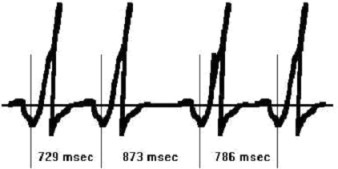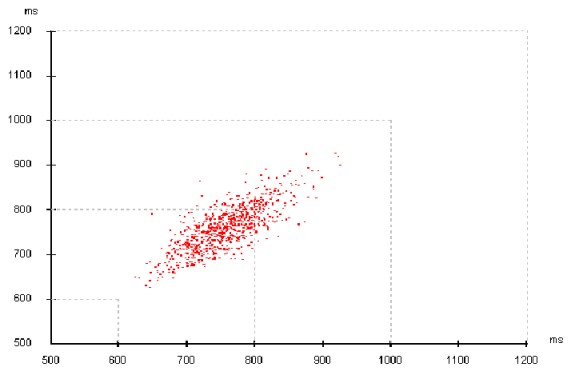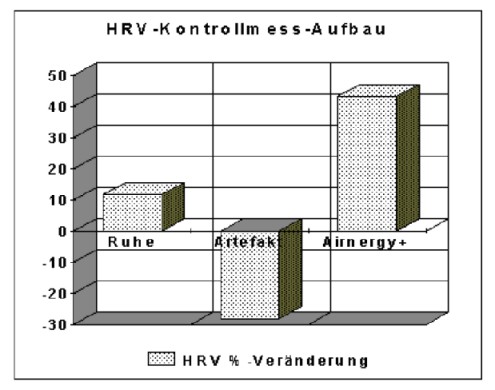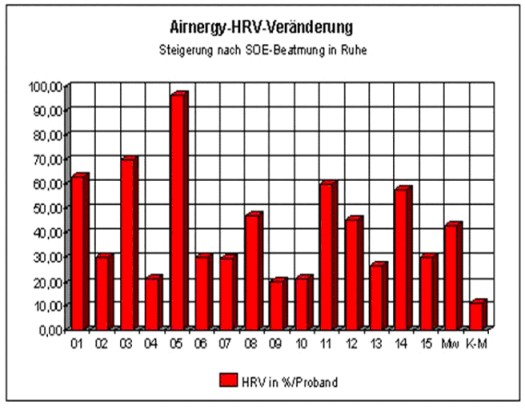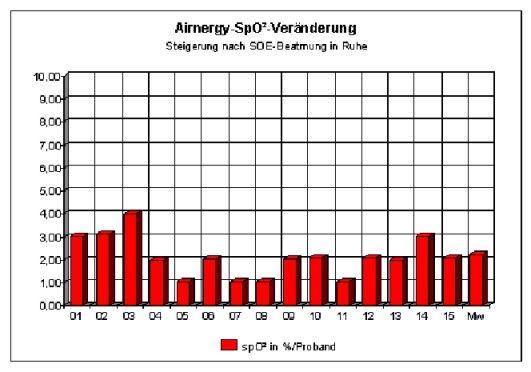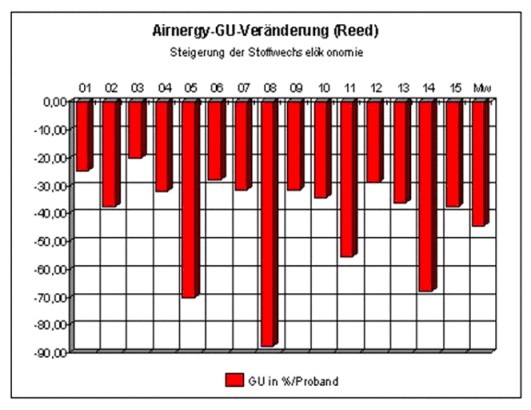Report on a two-stage controlled study, using heart -rate variability measurements (HRV) in respect of the effectiveness of the Airnergy+ Oxygen TherapyDr. Ulrich Knop
An innovative method for the retention and restoration of energy balance.
Airnergy+ is a new process of oxygen therapy. It uses the air we breathe instead of medical oxygen, as used in all other conventional processes and which, as a result, suffers from problems of dosage.
1. Introduction
In our institute, we have over 20 years of experience with oxygen multi-step therapies according to Ardenne, and in 1985 in Munich, together with Prof. Dr. M.v.Ardenne, we formed a large OMS-Institute ("med-O-vit"). Later we made intensive study of climatic conditions and the biological availability of different types of substrates. We concerned ourselves with the ionization of air in a room, with sea climates / refining plants and also with the ionization of medical oxygen.
The oxygen content of the air we breathe is activated by means of a chemo-luminescence process. As a result, the oxygen content becomes fully available for biological purposes.
Therefore, Airnergy+ would be the only process, where the oxygen content of the air we breathe is optimised where it is required, i.e. directly within the cell metabolism.
This seems to be a therapeutical breakthrough, since the effectiveness of oxygen utilization, i.e. its availability from within the blood, is a prime requisite for cellular metabolism. In order to keep healthy, cellular energy generation is one of its basic requisites.
Fig. 1 The HRV depicts the variability of pulse rate interval (beat to beat). These are clear values to indicate the normal controlled range of the autonomic nervous system. The higher the heart rate variability, the higher the resulting autonomous control potential.
Airnergy+ is now said to have this effect:
When normal air is being breathed, blood oxygen saturation with healthy lungs should not have changed much. Instead, the basic metabolism should quieten down since it can now operate more effectively – the BMR (Basal Metabolic Rate) should fall. If such an energy gain is applied directly to the organs and if their metabolism could function more effectively, then the HRV should also change, the autonomic nervous system should increase in its control capabilities and the autonomous control potential should widen. This results from the consistent reactivity of nerve tissues – and that means of the autonomic nervous system.
As a result, all organic functions would be controlled more purposefully, would operate more efficiently and would lead to a reduction in wear and ageing of all organs.
2. Heart Rate Variability (HRV) Measurements with the Airnergy+ Therapy.
To investigate such a claim, a two-stage controlled study was conducted by us from the beginning of August to the end of September 2003, using 15 resp. 5 test subjects. For purposes of evaluation we investigated the HRV values (variability width of heart rates).
Heart activity has a direct relationship with the autonomic nervous system and is influenced by various mechanisms. These are also under central control by the hypothalamus, the sympathetic and parasympathetic nervous system, and these are again affected by endogenous influences, such as breathing, blood pressure, heart pumping volume, temperature etc. Thereby, the autonomic nervous system is directly connected with to heart activity.
The biological control process is a finely balanced system. It is able to adjust its bio-feedback stabilisation. The biological activity of the body is shown by the adaptability of the organism to compensate quickly for different internal and external influences and in a correct manner. This is determined largely by the efficiency of the autonomic nervous system. Should such a vegetative control potential become disturbed, then biological stress will result – synonymous with functional disorder and illness.
The heart is affected through vegetative fibres directly by the vegetative sections of the central nervous system. Thereby the vegetative control quality can be directly depicted by the heart rate variability. Such variability implies that the pulse rate is basically regular, but follows no strict beat (this would imply rigidity of reaction). Instead, it occurs with a variable spread. Each heart beat differs from the previous one by minute variations in its signal repetition rate (Fig. 1)
The lack or reduction of such variation implies a rigidity or impairment of reaction and is biologically relevant (Figs. 2 and 3)
Fig. 2: This depicts an HRV spectrum with narrow spread. It shows an equally relatively limited control width within the autonomic nervous system. The tighter the spread, the greater its pathological importance. An absolute rigidity of reactions results in death.
Fig. 3: This depicts a good and well spread HRV spectrum. It also shows a relatively high control width within the autonomic nervous system. The broader the width of the spread, the more this indicates a more purposeful reaction capability of the organism. A wide spread and thereby a high variability indicates health.
Fig. 4: This bar chart shows the three mean values of the test sequences. The individual results of the test persons after Airnergy+ are the more significant, when viewed together with the rest- and artefact values. The spread width variations of the HRV-measurements of the three sequences speak for themselves.
It should be mentioned here, that HRV measurements cannot be influenced deliberately and these are therefore a very exact and secure instrument to investigate influences on the organism, especially its reactions with and without stress within the autonomic system and to be able to depict these later. This is why we deliberately used HRV measurements to investigate the Airnergy+ system.
3. The actual two-stage and counter-checked study.
To investigate this claim, we carried out a two-stage study, using 15, resp. 5 test persons. To assess the results, we used blood oxygen saturation values SpO², BRM values according to Read (function of Basal Metabolic Rate) and HRV values (width variability of heart rates).
To substantiate the claim, we would expect to see variations in these values. The energy gain, because of Airnergy+, would have to be felt immediately in the individual tissues and would have to affect the autonomic control in a positive, relieving manner, and it would be a requirement that all these could be verified by quantitative measurement.Our study was set up as follows:
For the initial examination we selected 15 healthy test persons of both sexes, between 15 and 45 years of age who would be representative of a normal population, neither sporty nor inactive, neither under- nor overweight. From this group we selected 5 test persons, 3 male, and 2 female who were representative of the whole group. The basal metabolic rates (BMR according to Read) were within the tolerance range for all: +4 to -1. Blood oxygen saturation (SpO²) was normal for all: between 97 and 99%.
At first, the test persons were subjected to a control examination where they passed through the same test sequence without, however, Airnergy+ or other therapeutic influences, to enable us to establish a basic rest value, to average this out and to apply this to the calculation of variation. Additionally some artefact tests were conducted whilst undergoing the Airnergy+ therapy. Noisy conditions where created, such as by reading aloud, so that we could include stress factors, causing stray readings, and could average out their effect on the HRV (Fig. 4). This resulted in a two-fold calibration of the test model.
Series examinations in the surgery followed, lying down at rest using Airnergy+, and always following the same sequence after a rest period of 15 minutes:
1. 10 min HRV-online measurements at rest with parallel ECG and SpO² check, blood pressure and pulse rate measurement.
2. 20 min respiration with Airnergy+ at 100%, also at rest.
3. 10 min HRV-online measurements at rest with parallel ECG and SpO² check, blood pressure and pulse rate measurement.
The obtained values were loaded into a statistical evaluation program and analyzed. To obtain a quantitative basis, we recorded online the heart beat rates and their variability, We then calculated the spread width of the heart beat rate variability and again determined the heart beat rates which we then correlated and related to each individual so as to obtain a relative, comparable value, which also took into account rest periods during the test and application. Absolute figures would not have helped much since we had to include the reaction of the appropriate test person and had to show this as a percentage. Thereby, we were able to compare the Airnergy – HRV change.Increase after SOE respiration at rest
HRV in % / test person
Fig.5: The bar chart above depicts the percentage improvement of the basal metabolic rate for the 15 test persons (01- 15). It shows individual improvements compared to the original values and this is thus an effective projection. The bar marked Mw is the derived mean value. The bar marked K-M is the mean value of the rest control measurements and we also know from other measurements, that the value is normally around 11%.
Airnergy SpO² - change
Increase after SOE respiration at restSpO² in % / test person
Fig.6: The bar chart above depicts the percentage improvement in oxygen saturation for the 15 test persons (01- 15), showing individual improvements compared to the original values and this is thus an effective projection. The bar marked Mw is the derived mean value. As expected, changes here were minimal.
Airnergy – BMR change (Read)
Increase in metabolic economyBMR in % / test person
Fig.7: The bar chart above depicts the percentage improvement in the basal metabolic rate for the 15 test persons (01- 15), showing individual improvements referred to the original values and this is thereby an effective projection. The bar marked Mw is the derived mean value. The partially large reduction in the BMR values for all test persons is remarkable and indicates a significant improvement in the metabolic economy.
Figures for each test person with all others were in relation to a relative base.
It allowed us numeric and individual standardization of the HRV values.
We tested 15 persons. The results (Fig.5) surprized us. We had expected improvements of around 20% or 25%, but the statistical analysis gave us figures with an average of 44%. Even if we ignore the normal rest developments in the HRV (on average 11%) then HRV improvements still amounted to more than 34% after Airnergy+ respiration of only 20 minutes. This is highly significant, since, without doubt, it shows that an immediate reaction of the autonomous nervous system has taken place, leading to optimization and a clear efficiency increase by increasing the control- and spread width of HRV reactions.
As expected, SpO² values changed very little (Fig. 6).Likewise, the BMR – Read values were improved by a significant reduction in the basal metabolic rate (Fig. 7). This speaks clearly for an optimization in the metabolic processes which can now function more efficiently without stressfully increased rates. It should be unnecessary to point out that a lower BMR reduces cell damage, wear and the aging of tissues.
The results can be summarized as follows:
The study with 15 test persons showed - especially when compared with the control examination - a significant effect of the Airnergy+ application on the autonomic nervous system. The HRV was improved in all cases and on average amounted to about 34% after allowing for the rest values.
Airnergy+ leads objectively to an improved organic energy balance which is also clearly shown by the optimization of the autonomous control capabilities.
The Airnergy+ treatment obviously acts through a quasi-physiological activation of the air we breathe in an immediate energy rise in the air-depending tissues. This leads to improved reactions and optimisation of the neurological control of all inner organs and this is consistent with a more stable and reactive basic health. Resources are saved, performance reserves are greater, the performance capacity is increased and the aging process of tissues is reduced. This will lead to stabilization and functional improvement of all organs and organic systems. The healing prognosis shows a lasting improvement and in many cases is able to progress more correctly since, obviously, it is now controlled in an optimum fashion.
4. Results after a series of respirations.
Since we were able to prove immediate benefits, we intended also to show the absolute effect after a series of respirations. For that purpose the 5 test person that had been selected for the initial series of tests were subjected for a further 9 respiration sequences of equal duration and intensity and also at rest. The interval here was 2 respirations per week. Such a selection had no therapeutic basis but was necessary simply for organizational reasons. After completion of the packet of 10 treatments the test persons were asked to present themselves 3 days later and were then subjected to the measurement at rest as described earlier under 3.). However, only the HRV values were recorded, since the BMR values could cast doubts on their validity because, it must be assumed, that the daily routines are different.
The HRV values, strictly related to the initial rest-values, also showed in the subsequent investigations remarkable improvements, when compared with their initial levels. On average an improved HRV spread of 19% could be found (compared to the original value basis). Even when subtracting the at rest values of 11%, we still retain an objective 8% improvement. The test persons felt better in their general health (5), felt mentally clearer (3) and physically more efficient (4).
5. Discussions
The studies conducted by our institute showed significant results in both parts (immediate and serial). On the basis of the arrangement of the studies we are able to disclose objectively initial results. The effect of the respiration chain, metabolism and the autonomic nervous system can be presented objectively and regularly, which satisfies the purposes of these investigations.
It would be desirable now to obtain also a detailed analysis, which includes placebo variants and a genuine component of 30 long-term respirations. We tend here towards a randomised double-blind study with 10 test persons whereby the placebo and the true Airnergy+ groups would each consist of 5 test persons.
We also intend to include patients suffering from burnout syndromes. Such an extension would be meaningful, since basic and objective values from a healthy group are now available.
Finally, we are of the opinion that a series of 10 respirations is insufficient for stabilization purposes, a fact which should be quite plausible. Our recommendation would be 30 respirations across 10 weeks at 3 per week.
6. Conclusions
Treatment with Airnergy+ obviously and significantly achieves an immediately improved reaction to the metabolic sequence and, simultaneously, an optimization of the neurological control of all inner organs. Logically, this leads to more stable basic health with increased reactivity.
Organic assets are being spared, reserves of power are increased and the process of tissue ageing is slowed down. In the end this leads to a stabilization and improvement of all organs and organic systems that are involved.
We recommend basically, that Airnergy+ should become the basis of treatments for all illnesses, or at least of those that relate to deficiencies in the immune- or metabolic systems. In addition, we believe that this form of treatment is a serious preventative measure that could be used by all, at least as a form of heath cure.
Dr. H.C. Ulrich Knop
Active since 1983 on a freelance basis in bionic and electro-biology studies. The MET is one of his developments and has been his subject for around 100 seminars. For several years he was also lecturer in medium-frequency therapy in the further education of general practitioners. Today he is the research chairman for the M.E.V. Association and concerns himself with several innovative products of different manufacturers.
Address of the author:
Knop-Institute für
medizin. Bionik
Doz. Dr. h.c.
Ulrich Knop, Ph.D
Mainzer Str. 6
D-55578 Wolfsheim
office@medizin-bionik.de
| Accueil | Airnergy | Bienfaits | Études | Articles | Nouvelles | Modèles | Contact |

